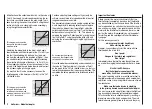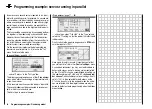
84
mx-16s programming techniques
Preparation, using a fi xed-wing model aircraft as an example
Programming model data into an mx-16s ...
... is easier than it may appear at fi rst sight.
There is one basic rule which applies equally to all pro-
grammable radio control transmitters: if the program-
ming is to go smoothly and the systems work as expec-
ted, the receiving system components must fi rst be in-
stalled correctly in the model, i.e. the mechanical sys-
tems must be fi rst-rate. This means: ensure that each
servo is at its correct neutral position when you fi t the
output lever or disc and connect the linkage to it. If you
fi nd this is not the case, correct it! Remove the output
arm, rotate it by one or more splines and secure it again.
If you use a servo tester, e.g. the Digital Servo Analyzer,
Order No.
763
, to centre the servos, you will fi nd it very
easy to fi nd the “correct” position.
Virtually all modern transmitters offer facilities for offset-
ting the neutral position of servos, but this is no substi-
tute for a correct mechanical installation; this function
is only intended for fi ne tuning. Any substantial deviati-
on from the “0” position may result in additional asym-
metry when the signal undergoes further processing in
the transmitter. Think of it this way: if the chassis of a car
is distorted, you may be able to force the vehicle to run
straight by holding the steering wheel away from centre,
but it does not make the chassis any less bent, and the
basic problem remains. Another important point is to set
up the correct control travels wherever possible by using
the appropriate linkage points in the mechanical system;
this is much more effi cient than making major changes
to the travel settings at the transmitter. The same rule
applies: electronic travel adjustment facilities are desig-
ned primarily to compensate for minor manufacturing to-
lerances in the servos and for fi ne adjustment, and not
to compensate for poor-quality construction and defecti-
ve installation methods.
If two separate aileron servos are installed in a fi xed-
wing model aircraft, the ailerons can also be employ-
ed as fl aps by defl ecting both of them down, and as air-
brakes by defl ecting both of them up – simply by set-
ting up a suitable mixer (see the section starting on the
next double page). Such systems are generally more of-
ten used in gliders and electric gliders than in power mo-
dels.
In such cases the servo output arms should be offset
forward by one spline relative to the neutral point, i.e. to-
wards the leading edge of the wing, and fi tted on the
servo output shaft in that position.
The mechanical differential achieved by this asymmet-
rical installation takes into account the fact that the bra-
king effect of the up-going ailerons increases with their
angle of defl ection, and this means that much less tra-
vel is usually required in the down-direction than the up-
direction.
Similar reasoning applies to the installation of the fl ap
linkage when separately linked fl ap servos are installed,
designed to be used in a butterfl y (crow) system. Here
again an asymmetrical linkage point is useful. The bra-
king effect of the crow system is provided primarily by
the down-movement of the fl aps rather than the up-mo-
vement of the ailerons, so in this case the servo output
arms should be angled aft, i.e. offset towards the trailing
edge of the wing, as this makes greater travel available
for the down-movement. When this combination of lowe-
red fl aps and raised ailerons is used, the ailerons should
only be raised to a moderate extent, as their primary
purpose in this confi guration is to stabilise and control
the model rather than act as brakes.
You can “see” the difference in terms of braking effect by
deploying the crow system, then looking over and un-
der the wing from the front: the larger the projected area
of the defl ected control surfaces, the greater the bra-
king effect.
This type of asymmetrical installation of the servo output
arms can also make sense when you are setting up split
fl aps or landing fl aps on a power model.
Once you have completed your model and set up the
mechanical systems accurately in this way, you are rea-
dy to start programming the transmitter. The instructions
in this section are intended to refl ect standard practice
by describing the basic general settings fi rst, and then
refi ning and specialising them to complete the set-up.
After the initial test-fl ight, and in the course of continu-
ed test-fl ying, you may need to adjust one or other of the
model’s settings. As your piloting skills improve and you
gain experience, you might feel the need to try out diffe-
rent control systems and other refi nements, and to ca-
ter for these requirements you may fi nd that the text de-
viates from the obvious order of options, or that one or
other of the options is mentioned more than once.
At this point, just before you start programming the mo-
Programming examples: Fixed-wing model
Outboard Ailerons
Inboard Camber-Changing Flaps
Summary of Contents for MX-16S
Page 1: ...1...
Page 17: ...17...
Page 31: ...31 Fixed wing models Installation and connections...
Page 35: ...35 Program description Reserving a new memory...
Page 47: ...47 Base settings Model helicopter...
Page 83: ...83 Fail safe...
Page 89: ...89 Programming examples Fixed wing model...
Page 109: ...109 Programming examples Model helicopter...
Page 112: ...112 112...
Page 116: ...116...
















































